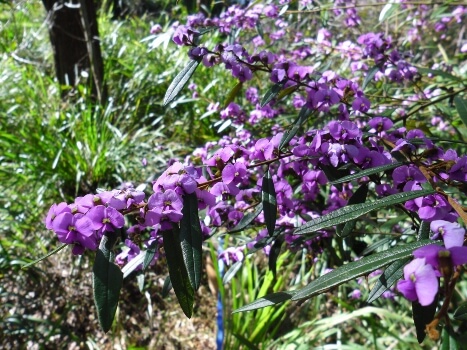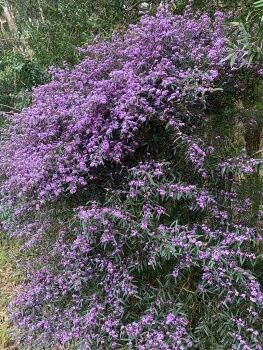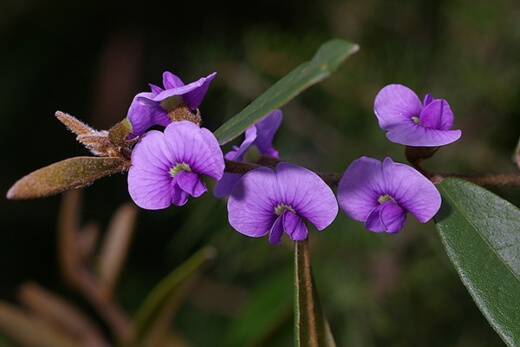When I think of the native Australian pea flower, any particular one, I think colour and elegance. I imagine pretty blooms dancing in the wind and a garden filled with colour. Hovea acutifolia is no exception and with its hues of blue or purple, it inspires many a happy daydream.
In our how to grow and care guide, we’ll share advice on how to propagate your own shrub from seed or from a cutting. We have care advice on everything from pruning to sunlight, info on common pests and diseases, and some frequently asked questions about this Australian native.
More...

Source: Paten Park Native Nursery
Family: | Fabaceae |
|---|---|
Genus: | Hovea |
Species: | acutifolia |
Common Names: | Purple Pea Bush |
Location: | Indoor and outdoor |
Type: | Shrub |
Growth: | Up to 1.5 metres tall and wide |
Sun requirements: | Full sun, part shade |
Foliage Colour: | Dark green and bronze underneath |
Flower Colour: | Purple |
Flowering: | Spring |
Fruit: | Pods that are edible |
Maintenance level: | Average |
Poisonous for pets: | No |
Introducing Hovea acutifolia
Hovea acutifolia is part of the Fabaceae family and makes its home in forest and rainforest from south eastern Queensland to New South Wales. Its common name is the purple pea bush.
The name Hovea is after Anton Hove who was a botanical collector while Acutifolia comes from the Latin word acutus which means pointed, and folius means leaf.
Purple Pea Bush Plant Features
The Hovea genus includes about 20 different species and they are all endemic to Australia. The shrub is small to medium in size and grows to around 1.5 metres in height and spread.
You’ll notice that the branches and stems of the plant are covered with plenty of hairs that can be a grey or rusty colour. The new leaf growth also has a rusty look. Hovea acutifolia flowers have a classic pea shape with 4 petals. They are a blue to purple colour.
How to Grow Hovea acutifolia

Source: Ecotone Nursery
This shrub is quite adaptable when it comes to climate – it can handle temperate and subtropical. It’s possible to propagate Hovea acutifolia quite easily from seed, especially if you follow the right pre-treatment to help break through the rather tough seed coat.
Hovea acutifolia is easy to please and can cope in full sun or partial shade, and can also grow in either dry or moist soil, as long as it’s well-draining. The shrub is great as a garden feature and does well in a small garden too.
You could use it to create a screen effect, or otherwise a more bushy and Mediterranean look.
Propagating Purple Pea Bush
Hovea acutifolia Propagation from Seeds
The seed of the Hovea acutifolia is released when the plant pods become brown and they eventually split open. The seed coat is hard which makes it difficult for water to get through. In order to help germination along, you’ll need to give the seed some kind of pre-treatment first.
The easiest way to treat the seed is by covering it with boiling water and you can leave it overnight. Check the next day for seeds that are swollen as these are the ones you can use.
For any seeds that didn’t swell up, you can apply boiling water again and leave overnight, repeating this process until you have the right amount of seed for planting. Some gardeners use sandpaper to rub down the seed which gets rid of the hardened outer coat.


Get Your Free Guide:
Master Growing Australian Natives eBook
A Must Have Complete Guide for Every Australian Garden
Get Your Free Guide:
Master Growing Australian Natives eBook
A Must Have Complete Guide for Every Australian Garden
Once you have your seed ready for sowing, you can plant it in vermiculite that has been moistened and put it in a closed container. Germination will take between 1 to 2 weeks. Check the root growth and once there is at least a centimetre of root visible, you can replant the seedling into a pot.
Propagating Hovea acutifolia from Cuttings
Choose a cutting that is around 75mm long. You’ll need to remove the leaves from the bottom two thirds of the cutting. Pretreat the lower part of the stem by removing bark and dipping it into a rooting hormone. You can then plant the cutting accordingly.
Hovea acutifolia Care Guide

Source: Coolum Native Nursery
Sunlight
Hovea acutifolia needs enough light to grow happily. It can grow in full sun but actually likes partial shade for the best effect. If you start to notice leaf drop, it probably means the plant isn’t getting enough sunlight.
If your plant is indoors, you can place it not more than a meter away from a south-facing window.
Watering Schedule
As a guideline, you can give your Hovea acutifolia half a cup of water every 10 days if it’s not directly in the sun. The plant does well with mulching to help lock in moisture levels.
Soil
Hovea acutifolia does well with a well-draining soil. The moisture levels can vary between letting the soil dry out between watering sessions or keeping the soil moist. pH levels can be slightly acidic to slightly alkaline.
What Fertiliser to Use
You’ll need to repot your Hovea acutifolia when it doubles in size or once a year. When it comes to fertilising, you could use manure pellets and leaf litter or a granular fertiliser that is low in phosphorus. There are some great seaweed solutions on the market too.
Pruning Purple Pea Bush
Hovea acutifolia does well when pruned. The plant has quite a short life span and doesn’t usually live longer than 7 years. You can aim for a light pruning once a year after flowering has happened. It will encourage more plant growth and flowers.
Common Purple Pea Bush Pest and Diseases
Brown spot
The leaves of the plant as well as the stems and pods will have what looks like water marks on them. These eventually become a darker colour and look like a burn. The leaves might also dry up and drop off the plant.
Brown spot usually spreads via infected seed and the bacteria that causes the disease can survive in soil for a few months. If a plant has been damaged it is more easily affected.
Be sure not to overwater your plant. Rather let soil dry out between watering. In terms of treatment, you can use a copper based fungicide and remove the parts of the plant that have been affected.
Gray mold (Botrytis mold)
Gray mold loves moisture so if your plant is wet, they are at a higher risk of picking up an infection. Any injury on your Hovea acutifolia also makes it more susceptible. The plant will have what look like water spots on their leaves.
They start off as a white colour and this then changes to brown and covers the leaves, which then wilt. The mold can also affect other parts of the plant including its stems and petals. After a while, the parts of the plant that are infected all look like they’re covered with a fuzzy gray growth.
You’ll need to get rid of the infected plant to avoid the disease spreading to other garden plants. You can minimise the risk of future infections by being careful with your Hovea acutifolia when doing any pruning, to try and prevent any wounds to the plant.
Try to keep the plant dry by not watering from above, and also don’t water at the end of a day. Good air flow between plants is also important.
Powdery mildew
When dealing with a powdery mildew infection, you’ll see yellow spots on the leaves and greyish white spots that look like powder. These powdery looking spots can eventually cover a whole plant.
The fungus that causes this likes warm and dry weather which provides optimum conditions. If the infestation is very severe, you can use a sulphur based fungicide for treatment.
Aphids
Aphids are small insects that like to hang out underneath leaves. They can be a whole range of different colours. If the aphid infestation is quite large you might notice that the leaves become yellow and start to develop spots.
The growth of the plant is also affected. The insects secrete a substance that is sticky called honeydew and this secretion causes another problem – sooty mould.
For smaller infestations you can just prune off the parts of the plant that are affected. You can also spray the plant with a strong stream of water to knock them off. In the case of a bigger infestation, you’ll need to use an insecticidal soap or something like neem oil for treatment.
Spider mites
The leaves of your plant might have bits of yellow and start to look bronze. There is often a web type of covering on the leaves and you might even be able to see the mites, as tiny as they are. Once the leaves become yellow they might begin dropping off the plant.
You can spray your plant with a strong stream of water to move the spider mites along. If you are dealing with a bigger infestation on your hands, you can use an insecticidal soap for treatment.
Hovea acutifolia Frequently Asked Questions

Source: Australian Native Plants Society
Does the Hovea acutifolia attract any wildlife?
It attracts bees and birds.
Can you eat Hovea acutifolia?
Yes, it is a much loved bush tucker. You can eat the young pods as they are off the plant, or fry them up to eat.
What special features does Hovea acutifolia have?
The plant is clay and drought tolerant and can handle light frost and salty conditions.
What is Hovea acutifolia most commonly used for in the garden?
This shrub is incredibly popular as a screening plant.
Where is Hovea acutifolia used for landscaping?
It is often planted along roadsides and in parks. The shrub is great for erosion control.
Is Hovea acutifolia a fast growing shrub?
Yes, it is a fast grower.
Get more gardening inspiration and advice when signing up for our newsletter.Wrapping Up Our Hovea acutifolia Growing and Care Guide
The Australian native pea flowers are vibrant and a lovely collection to add to your garden. They provide ‘rooms’ for the garden, colour and fragrance. Hovea acutifolia is hardy and easy to maintain.
It’s equally easy to propagate, and although the plant doesn’t have a long lifespan, it brings immense joy when in bloom. We’re giving this native shrub our green thumbs up.
Published on January 17, 2023 by Nathan Schwartz
Last Updated on January 26, 2025




